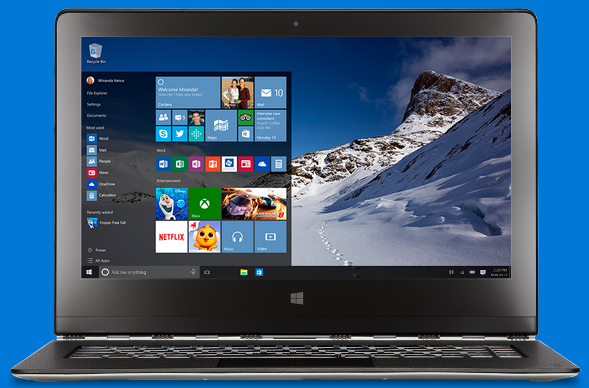
SAN FRANCISCO – Microsoft’s new Windows 10 operating system debuts Wednesday, as the longtime leader in PC software struggles to carve out a new role in a world where people increasingly rely on smartphones, tablets and information stored online.
No one’s expected to line up overnight for Windows 10, the way people did 20 years ago for Windows 95. But Microsoft is counting on tens or even hundreds of millions of people to download its latest release for free in the coming months. The launch will be accompanied by a global marketing campaign for an event the company hopes will be pivotal – both for its own future and for a vast audience of computer users around the world.
Windows 10 is coming to PCs and tablets first, but it’s also designed to run phones, game consoles and even holographic headsets. It has new features, a streamlined Web browser called Edge and a desktop version of Cortana, the online assistant that is Microsoft’s answer to Google Now and Apple’s Siri.
Still, the company insists Windows 10 will seem familiar to users of Windows 7, the six-year-old operating system still running on most PCs. Microsoft and PC makers want to erase the memory of the last big update, 2012’s Windows 8, which alienated many with its jarring, unwieldy design.
Microsoft skipped the name Windows 9, as if to distance itself further from the last release. While many analysts believe Windows 8 made sagging PC sales even worse, it’s unclear if Windows 10 will spur the industry back to growth.
Here’s a look at the launch and why it matters:
Q: What happens this week?
A: Microsoft plans promotional events in several cities Wednesday, tied to a global ad campaign and a series of charitable donations. About 5 million people who enrolled in an earlier test program will be able to download Windows 10 right away.
The company is also offering Windows 10 as a free download, any time over the next year, to anyone who has the Home or Pro versions of Windows 7 or 8 (but not the Enterprise versions used by big organizations). Some may not get it the first day; Microsoft says it will deliver downloads in waves, to ensure things go smoothly, but it hasn’t said how long that will take. Details on how to upgrade are here: http://bit.ly/1eNCySl.
Retailers such as Best Buy, Staples and Wal-Mart will have some desktops and laptops with Windows 10 already installed. More models are coming.
Q: Why is Microsoft giving Windows 10 for free?
A: The company wants to get the new software on as many devices as possible. Microsoft needs a large pool of users to convince independent programmers that it’s worth their time to build useful or entertaining apps for Windows 10 devices. Executives also believe that if people are exposed to the latest and best Windows, they’re more likely to try other Microsoft products on PCs and mobile devices.
CEO Satya Nadella says he wants to have 1 billion devices running Windows 10 in three years. Microsoft estimates there are 1.5 billion people who currently use some kind of Windows. Rather than charging them to upgrade, as Microsoft used to do, it’s embracing the free download model pioneered by Apple and Google.
Q: How will Microsoft make money?
A: Microsoft will still collect licensing fees from PC makers that install Windows 10 on new machines. In recent years, most consumers have waited until they bought a new computer to get the latest Windows. Microsoft also makes money from selling Windows and other software to large businesses and organizations.
In addition, Microsoft is counting on Windows 10 to spur more use of other services. Microsoft makes money from selling advertising for its Bing search engine, and Windows 10 comes with many apps that steer people to Bing. The company also collects fees from people who use premium versions of its Office software, OneDrive cloud storage and Skype.
Q: Why does this matter to consumers?
A: Microsoft says Windows 10 is designed for the way people use computers today – with a faster Web browser and features that make it easier to start tasks on a PC and then switch to a hand-held device. (Apple and Google tout similar features in their software.)
Windows 10 also lets users log in with their face, iris or thumbprint, instead of remembering passwords, though this works only with computers equipped with the right hardware.
Most PC users are still working with Windows 7, thanks to Windows 8’sunpopularity. But Microsoft plans to phase out maintenance and security support for Windows 7 over the next five years and for Windows 8 by 2023, as it did with the older Windows XP. Still, there’s no need to panic about upgrading right away.
Q: Why is it important to the tech industry?
A: The growth in mobile devices has caused PC sales to decline for more than three years, hurting manufacturers like Hewlett-Packard and companies like Microsoft and Intel, whose products are used with PCs.
Windows 10 won’t make people give up their hand-held gadgets, but it’s part of Nadella’s strategy to reposition Microsoft for a world where people use multiple devices. PC makers are hoping he succeeds.
Jeff Barney, who runs Toshiba’s consumer PC business, said the new software is easier to use than Windows 8 and will complement hardware advances in Toshiba’s newest machines. Although Barney isn’t expecting a big rush to stores Wednesday, “over time, I think we’re going to see a positive trend in sales.”